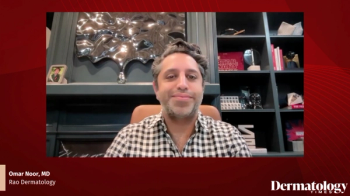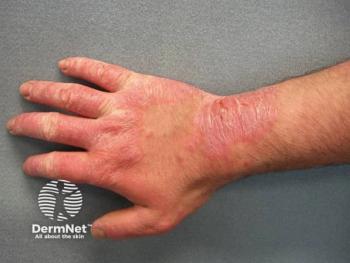
Understanding the Role of the Microbiome in Rosacea
Over the past few years, research on the microbiome and dysbiosis has gained interest in the potential exacerbation of several skin diseases, including rosacea.
Creating public awareness about rosacea is essential for medical providers, especially in understanding the psychosocial impact it can have on individuals. Clinicians play a crucial and empowering role in educating patients, particularly those newly diagnosed, about their condition and how to manage it effectively. This proactive approach can prevent the condition from worsening, saving the patient both frustration and the financial burden of managing the condition. The clinician's commitment to patient education is key, as it is in all skin diseases, and should address all aspects during the patient visit, including the role of the microbiome in rosacea.
Over the past few years, research on microbiome and dysbiosis has gained interest in the potential exacerbation of several skin diseases, including rosacea, atopic dermatitis, psoriasis, and hidradenitis suppurativa. Rosacea is taking center stage in April for Rosacea Awareness Month, and this emphasis on rosacea is not just a formality but a crucial step in raising awareness and understanding of the condition, encouraging action, and promoting patient education. Understanding this impact is vital for effectively communicating with our patients about the various ways they can manage their rosacea signs and symptoms.
Recent research highlights the pivotal role of the gastrointestinal (GI) tract in shaping the body's overall microbiome. This key insight is shaping our understanding of rosacea and its management. One fascinating aspect is that patients with rosacea share common microbiota in the skin, such as Cutibacterium acnes, Demodex folliculorum, Bacillus oleronius, Staphylococcus epidermidis, and in the GI tract, such as Helicobacter pylori.1 This finding highlights the profound interconnectedness of the body's systems and their mutual influence. A study published in Frontiers in Microbiology in 2023 reviewed the pathogenic role of these bacterial species in individuals with rosacea, further highlighting this interdependence.1
The skin barrier is a crucial component of overall skin health, and a healthy barrier, in conjunction with the commensal microbiome, helps regulate immune responses.1 Internal or external disruption can compromise the barrier, triggering an adaptive immune response and overexpressing Th1/Th2 cells, as well as an innate immune response that overexpresses toll-like receptor-2 (TLR-2).2 Matrix metalloproteinases are expressed at higher levels in patients with rosacea, leading to the breakdown of extracellular matrix proteins, such as collagen, which further disrupts the barrier and dysregulates the microbiome.1,2 Finally, a class of antimicrobial peptides known as cathelicidins plays a role in the innate immune system by protecting against infections, which are amplified in patients with rosacea.3 In rosacea, a higher level of the common microbiota shared in patients' skin and GI tract indicates a likelihood of dysregulation. Furthermore, GI comorbidities have been highly reported in patients with rosacea.1
In a 2020 systematic review of the impact of the microbiome on patients with rosacea published by Daou et al, the authors found that associations between rosacea and inflammatory GI ailments exist.4 The study also suggests that targeting inflammation to reduce dysbiosis within the skin and GI tract has proven effective in treating rosacea. This promising research suggests that understanding and managing the microbiome could be a key strategy in treating rosacea, offering hope for improved patient outcomes. However, it also underscores the need for ongoing research and the active involvement of the medical community in advancing our understanding and treatment of rosacea.
Although the pathophysiology of rosacea is not fully understood and is often debated, current treatments, such as pharmacological management and laser therapy, target the symptoms and not the underlying cause.4 Extensive patient education is not only a cornerstone of management but also a crucial responsibility, ensuring medication compliance, monitoring, and avoidance of triggers. As more data about the interdependence of skin and GI systems emerges, a greater emphasis should be placed on the impact of microbiomes on disease, reinforcing commitment to patient care and highlighting the importance of ongoing education for both clinicians and patients.
When focusing on treatment, consider the variability of the microbiome due to a patient's age, sex, use of cosmetics, antibiotics, and exposure to the environment.1 Sudden changes in temperatures are known to flare rosacea and more interestingly, the commensal activity of microbiota on the skin may be altered by skin temperature, for example, the Demodex mite thrives in warmer temperatures.1 Further research has found that S. epidermidis is more diverse and has higher levels in individuals with rosacea than in those without the condition.1 It is also postulated that H. pylori and an overgrowth of other microbes in the GI tract lead to the production of cytokines, causing an inflammatory response that affects immune regulation and results in increased permeability and overall dysregulation, known as "leaky gut."1
According to research, the immune system in patients with rosacea appears to play a significant role in the disease. Microbiota dysbiosis may upregulate the immune system, leading to the exacerbation of the disease. Although more research is needed on the treatment of rosacea with topical postbiotics or oral probiotics, some small studies have yielded promising results in helping restore a healthy skin barrier; however, the deficiencies in evidence of other studies have been questioned.3 Nonetheless, probiotic supplementation may play a significant role when combined with other therapies. Consider specific strains such as Bifidobacteria and Lactobacillus, as they have been used in treating specific skin diseases and specifically, Bacillus if they have noted H. pylori.1,3 Topically, Vitreoscilla filiformis has shown some promise as well.3 Overall, specific strains at specific doses should be considered as an adjunct to rosacea treatment and management, and further research is needed. However, understanding the importance of microbiomes is crucial when discussing this topic with patients.
Renata Block, MMS, PA-C, is a board-certified physician assistant and instructor at Rush University in Chicago, Illinois, a Dermatology Times editorial advisory board member, and the past president of the Society of Dermatology Physician Associates (SDPA) and the Illinois SDPA.
References
- Zhu W, Hamblin MR, Wen X. Role of the skin microbiota and intestinal microbiome in rosacea. Front Microbiol. 2023 February 10;14:1108661. doi: 10.3389/fmicb.2023.1108661.
- Rosacea - StatPearls. National Library of Medicine. Updated August 28, 2023. Accessed March 28, 2025.
https://www.ncbi.nlm.nih.gov/books/NBK557574/ - Sánchez-Pellicer P, Eguren-Michelena C, García-Gavín J, et al. Rosacea, microbiome and probiotics: the gut-skin axis. Front Microbiol. 2024 Jan 8;14:1323644. doi: 10.3389/fmicb.2023.1323644.
- Daou H, Paradiso M, Hennessy K, Seminario-Vidal L. Rosacea and the microbiome: a systematic review. Dermatol Ther (Heidelb). 2021 Feb;11(1):1-12. doi: 10.1007/s13555-020-00460-1. Epub 2020 November 10.
Newsletter
Like what you’re reading? Subscribe to Dermatology Times for weekly updates on therapies, innovations, and real-world practice tips.



















